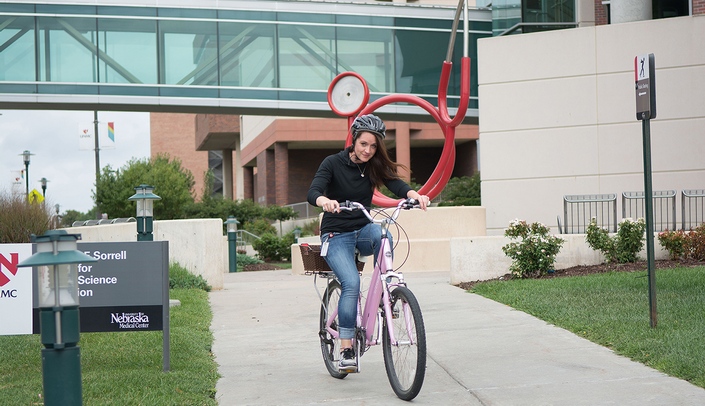In 2012, the University of Nebraska Medical Center and Nebraska Medicine set a lofty goal to boost the use of active transportation to and from the 42nd Street campus.
Their goal – go from 12 percent active transportation use to 20 percent by 2023.
Now, six years ahead of schedule, the campus has exceeded that goal, boasting 22 percent of trips are made by active transportation, which includes riding the bus, walking, biking and carpooling.
That is especially relevant for an organization whose mission is to “create a healthy future for all individuals and communities,” said UNMC Chancellor Jeffrey P. Gold, M.D.
The increase in active transportation use means less pollution and improved air quality, he said, especially for individuals with asthma, chronic obstructive pulmonary disease (COPD) and other lung ailments. It also means less congestion on the medical center campus and surrounding city streets.
“A significant number of people in our community work or study at a Nebraska Medicine or UNMC facility. Our colleagues and students are uniquely positioned to positively affect traffic and air quality in this area,” said Dan DeBehnke, M.D., M.B.A., CEO of Nebraska Medicine.
Since June 2015, thousands of faculty, staff and students have registered to participate in TravelSmart, an innovative campus program to encourage colleagues and students to bus, walk, bike and carpool to receive free parking, reduce emissions, be healthier, reduce stress and save money.
“We have reduced single-occupant vehicle miles by more than 29,000 miles per week,” said Melanie Stewart, sustainability manager for UNMC and Nebraska Medicine. “That’s 1.2 trips around the equator each week and 6.3 round trips to the moon each year, and all of the emissions associated with those miles.”
Benefits to using active transportation extend well beyond UNMC employees and students, Stewart said. “Less cars on the road not only reduces emissions and improves air quality, but also reduces traffic congestion and wear on city streets, while making it safer for all commuters,” she said.
Campus officials aren’t resting on their laurels. Already, they have set a new goal that coincides with sustainability goals related to emissions, water and waste. If all goes as planned, the medical center will, by 2030, reach 35 percent active transportation use, in addition to being carbon neutral, achieving zero waste and using less water than what falls on campus during an average rainfall year.
We are Nebraska Medicine and UNMC. Our mission is to lead the world in transforming lives to create a healthy future for all individuals and communities through premier educational programs, innovative research and extraordinary patient care.
Twitter | Facebook | Instagram | YouTube | Flickr
